Re: Along The Gilpin Tramway - The Wood Mine.
Posted by Keith Pashina on Feb 16, 2025; 5:45am
URL: http://c-sng-discussion-forum.254.s1.nabble.com/Along-The-Gilpin-Tramway-A-Closer-Look-tp20380p20501.html
PROSSER GULCH, at M.P. 40.31
In this post, we will look at the Prosser Gulch area. Prosser Gulch, sometimes called Pioneer Gulch, is third gulch crossed by the Gilpin Tram as it climbs up to the mines from Black Hawk.
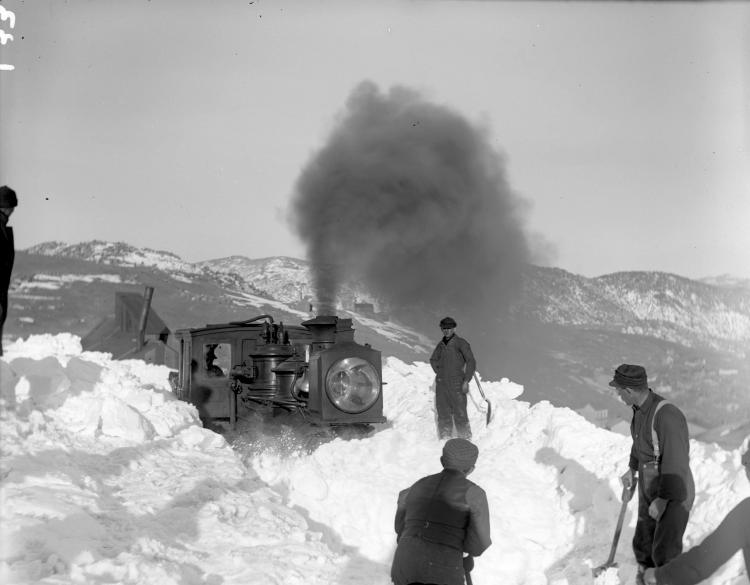
The Gilpin Tram crew is shoveling out after one of the big blizzards, on main line approaching Prosser Gulch. This view is looking northward, and has been published several times before. In the background is the Woods Mine, which we looked at in the previous post. The spur to the Woods Mine would have been a facing point switch for trains.
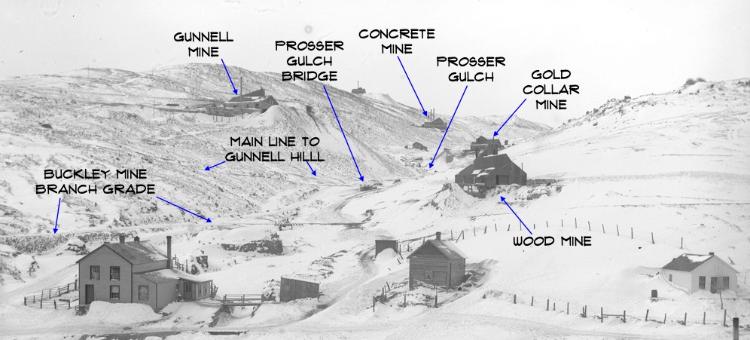
The mining districts around Central City, Nevadaville, and Russell Gulch were crowded with mines, and Gunnell Hill was no exception. This photo shows some of the mines. The Buckley Mine branch can be seen just below the Woods Mine, and below the mainline. Prosser Gulch is in the center, and the subject of this post.
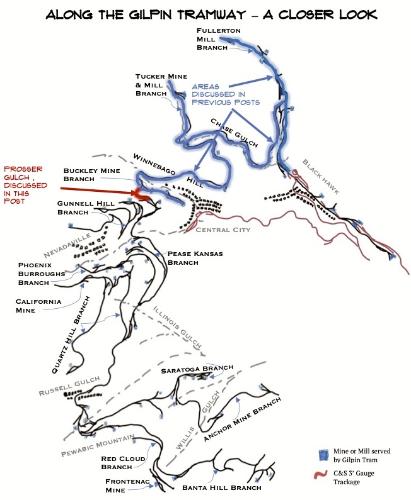
This map shows the location of Prosser Gulch, and what areas have been discussed in previous posts.
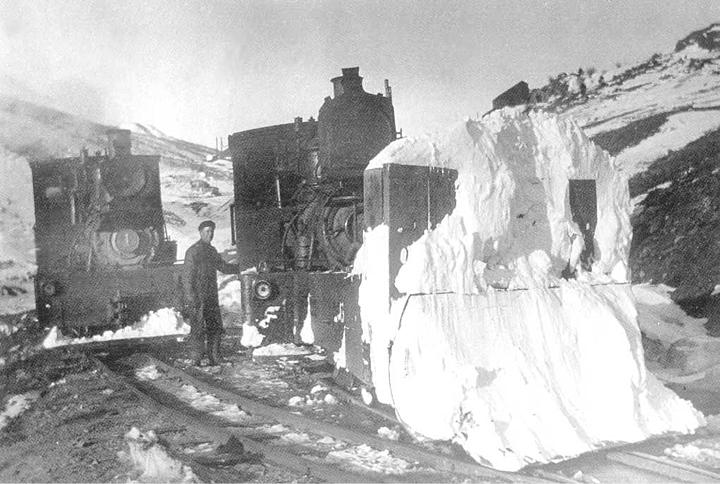
The two locomotives are parked at the Gold Collar Mine spur. This spur was built to load out ore and bring in supplies, and was located downgrade from the mine, perhaps 100' lower in elevation. A steep, winding wagon road led up to the mine.
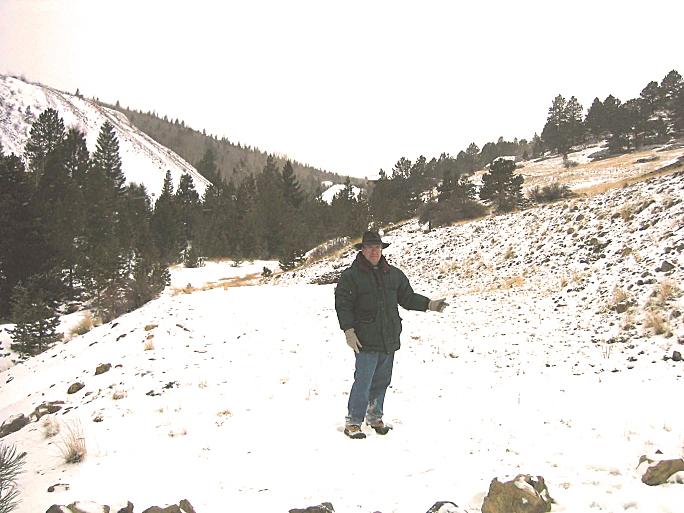
Joe Crea explored the site about 20 years ago, and is standing at about the same spot as in the previous photo=. The old grade remains, but there are a lot more trees that have grown in the area.
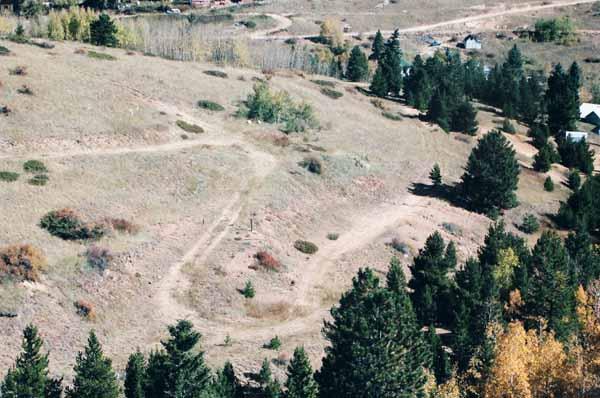
This photo is looking north from the Gunnell Mine site, on Gunnell Hill, and south of Prosser Gulch. The main line was graded across a gentle slope, and the S-curved mine road from the Gold Collar Mine can be seen leading down to where the spur would have been.
M.P. 40.27 Gold Collar Mine Spur:
The Gold Collar Mine was about 100’ feet uphill of the mainline at this point. Dan Abbott, in the Gilpin Railroad Historical Society Newsletter No. 4, writes “The Gold Collar Mine was on the north side of Prosser Gulch just above its junction with Eureka Gulch. The shaft was 712 feet deep, how- ever, having been idle for many years, by 1910 it could only be descended to the 332-foot level.
In September of 1911, lessees had begun to reopen the 332, 257 and 200 foot levels. The total production of the mine was about $250,000.
The 180-foot spur for the Gold Collar Mining & Milling Company was completed and ready for use on March 26, 1910. The entire cost of this spur -$289- was borne by the Gilpin Railroad Company and the track was the property of the railroad company.
This spur was built to provide a loading point for the Gold Collar Mine and to better facilitate handling ore for the Casto Mill. Construction began March 23 and was completed just three days later."
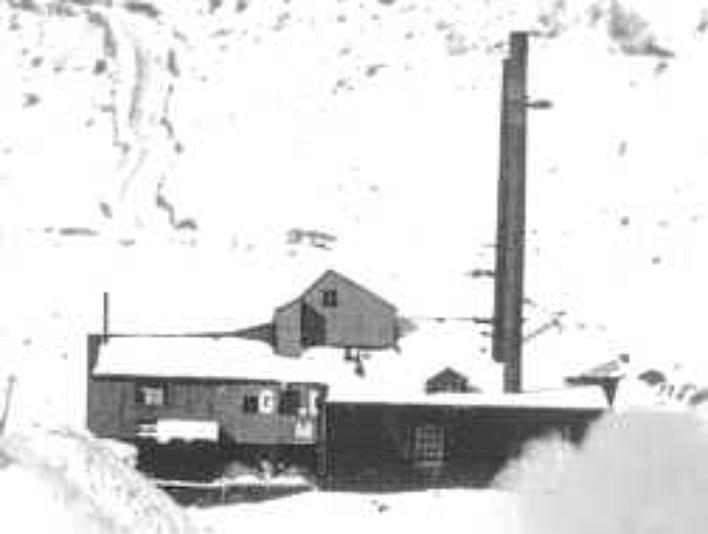
A close-up view of the Gold Collar Mine, enlarged from a Denver Public Library, Western History Collection image.
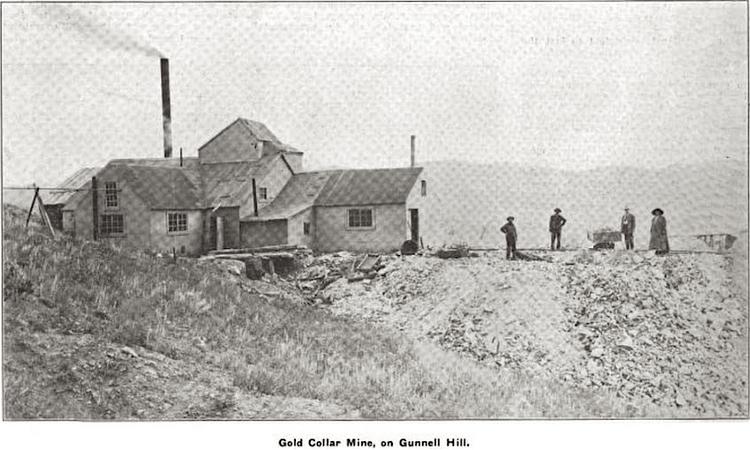
The January 1907 Mining Investor Magazine had this view of the west side of the Gold Collar Mine.
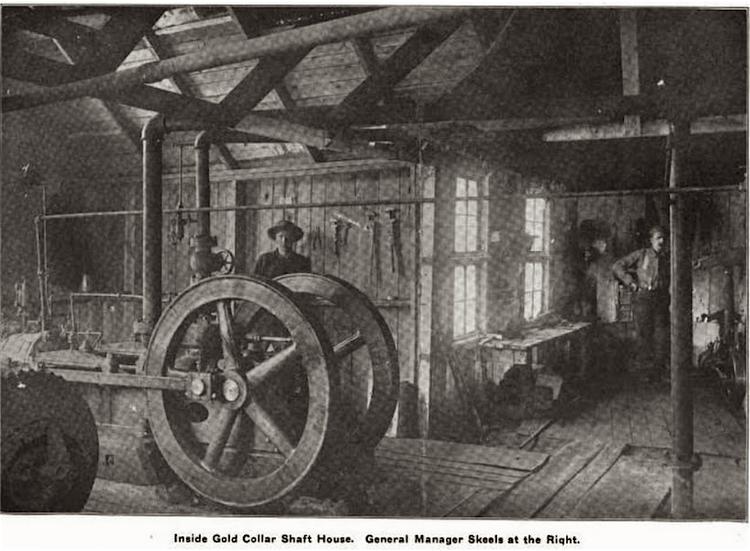
The January 1907 Mining Investor Magazine had this nice view of the shaft house interior of the Gold Collar Mine.
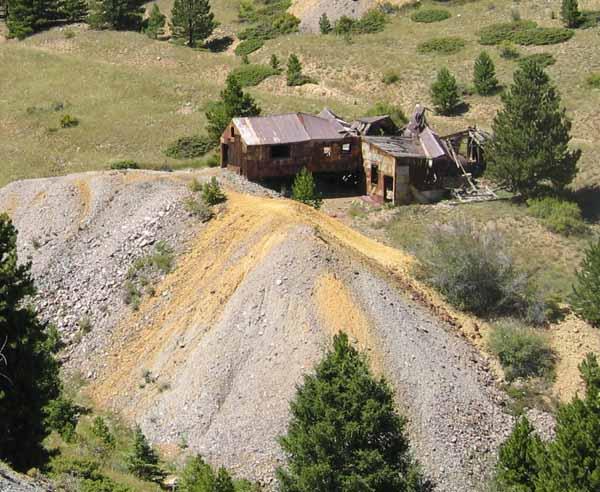
The Gold Collar Mine still exists, but showing the effects of the harsh winters, and is partly collapsed. Quite a bit of the structure was standng in 2005, when I took this photo. Mike Blazek sells plans for this mine. The waste dump is a nice mix of yellow and gray rock. Other researchers have told me the gold ore was gray in color, and shows up white in old photos. The chemistry of much of the rock in Gilpin County is such that it weathers to the yellow color is familiar with today. I would guess the dumps have a lot of sulphur-bearing compounds in them - on warm, sunny days, many of the dumps have a slight sulphur odor to them.
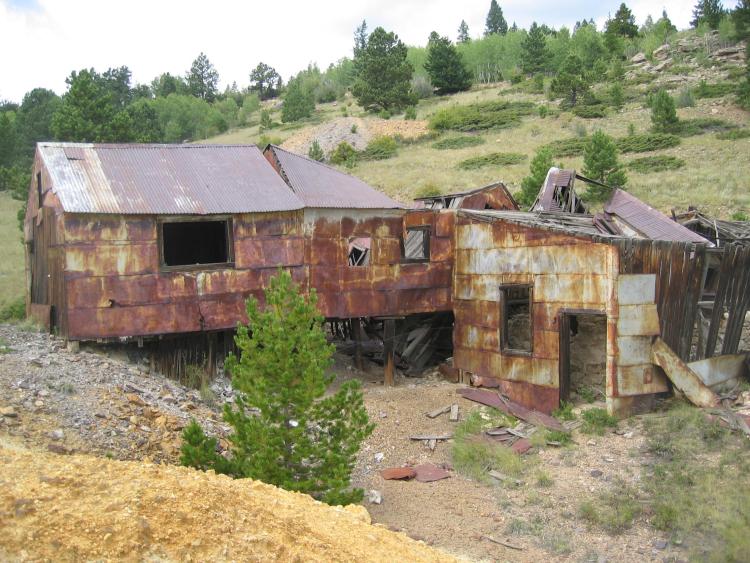
A contemporary view of the south and east sides of the Gold Collar Mine. It was clad with flat metal siding nailed to wood boards.
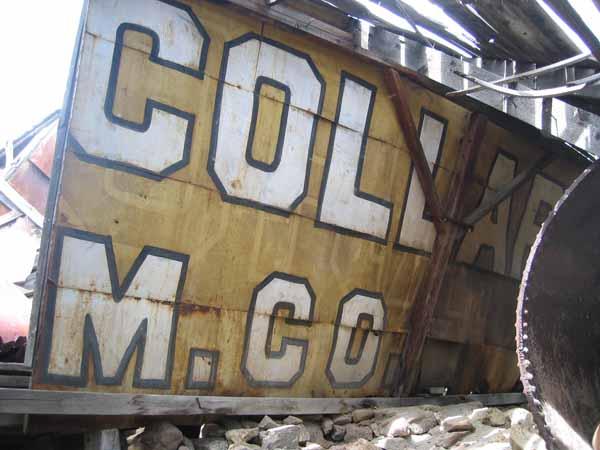
When poking around the mine, this wall was found. The painted wall was covered and protected by a later building addition, and still in relatively good condition. I like the large, block lettering style. The mine appeared to have been painted yellow - somewhat unusual, as most mines in the area appeared to be either unpainted or painted a red or earth brown color.
URL: http://c-sng-discussion-forum.254.s1.nabble.com/Along-The-Gilpin-Tramway-A-Closer-Look-tp20380p20501.html
PROSSER GULCH, at M.P. 40.31
In this post, we will look at the Prosser Gulch area. Prosser Gulch, sometimes called Pioneer Gulch, is third gulch crossed by the Gilpin Tram as it climbs up to the mines from Black Hawk.

The Gilpin Tram crew is shoveling out after one of the big blizzards, on main line approaching Prosser Gulch. This view is looking northward, and has been published several times before. In the background is the Woods Mine, which we looked at in the previous post. The spur to the Woods Mine would have been a facing point switch for trains.

The mining districts around Central City, Nevadaville, and Russell Gulch were crowded with mines, and Gunnell Hill was no exception. This photo shows some of the mines. The Buckley Mine branch can be seen just below the Woods Mine, and below the mainline. Prosser Gulch is in the center, and the subject of this post.

This map shows the location of Prosser Gulch, and what areas have been discussed in previous posts.

The two locomotives are parked at the Gold Collar Mine spur. This spur was built to load out ore and bring in supplies, and was located downgrade from the mine, perhaps 100' lower in elevation. A steep, winding wagon road led up to the mine.

Joe Crea explored the site about 20 years ago, and is standing at about the same spot as in the previous photo=. The old grade remains, but there are a lot more trees that have grown in the area.

This photo is looking north from the Gunnell Mine site, on Gunnell Hill, and south of Prosser Gulch. The main line was graded across a gentle slope, and the S-curved mine road from the Gold Collar Mine can be seen leading down to where the spur would have been.
M.P. 40.27 Gold Collar Mine Spur:
The Gold Collar Mine was about 100’ feet uphill of the mainline at this point. Dan Abbott, in the Gilpin Railroad Historical Society Newsletter No. 4, writes “The Gold Collar Mine was on the north side of Prosser Gulch just above its junction with Eureka Gulch. The shaft was 712 feet deep, how- ever, having been idle for many years, by 1910 it could only be descended to the 332-foot level.
In September of 1911, lessees had begun to reopen the 332, 257 and 200 foot levels. The total production of the mine was about $250,000.
The 180-foot spur for the Gold Collar Mining & Milling Company was completed and ready for use on March 26, 1910. The entire cost of this spur -$289- was borne by the Gilpin Railroad Company and the track was the property of the railroad company.
This spur was built to provide a loading point for the Gold Collar Mine and to better facilitate handling ore for the Casto Mill. Construction began March 23 and was completed just three days later."

A close-up view of the Gold Collar Mine, enlarged from a Denver Public Library, Western History Collection image.

The January 1907 Mining Investor Magazine had this view of the west side of the Gold Collar Mine.

The January 1907 Mining Investor Magazine had this nice view of the shaft house interior of the Gold Collar Mine.

The Gold Collar Mine still exists, but showing the effects of the harsh winters, and is partly collapsed. Quite a bit of the structure was standng in 2005, when I took this photo. Mike Blazek sells plans for this mine. The waste dump is a nice mix of yellow and gray rock. Other researchers have told me the gold ore was gray in color, and shows up white in old photos. The chemistry of much of the rock in Gilpin County is such that it weathers to the yellow color is familiar with today. I would guess the dumps have a lot of sulphur-bearing compounds in them - on warm, sunny days, many of the dumps have a slight sulphur odor to them.

A contemporary view of the south and east sides of the Gold Collar Mine. It was clad with flat metal siding nailed to wood boards.

When poking around the mine, this wall was found. The painted wall was covered and protected by a later building addition, and still in relatively good condition. I like the large, block lettering style. The mine appeared to have been painted yellow - somewhat unusual, as most mines in the area appeared to be either unpainted or painted a red or earth brown color.
Keith Pashina
Narrow-minded in Arizona
Narrow-minded in Arizona
| Free forum by Nabble | Edit this page |